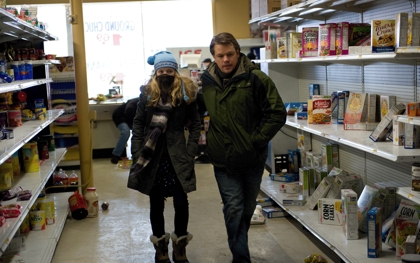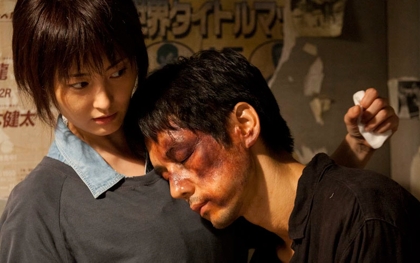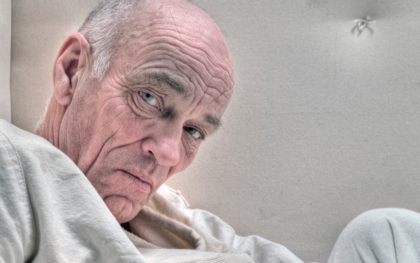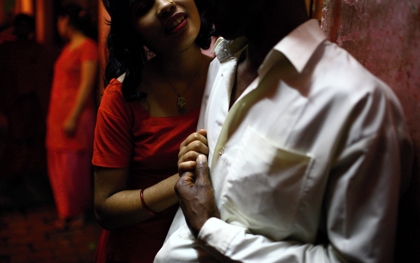Festivals
Venice Film Festival 2011: The S&S blog
Day four: Wreckage and survival

Contagion
Kieron Corless, 4 September
Day four of the festival but the first complete one for me, with last night’s showing of Yorgos Lanthimos’s monumental (and extremely divisive) Alps still flowering insidiously and subversively in my head as I set off for the 9am press screening (see Barbara Wurm’s day three report). By common accord the festival lumbered sluggishly through its first two days, but really caught fire yesterday. I’m hopeful today will match it.
First up is Steven Soderbergh’s Contagion. Barely five minutes in, Gwyneth Paltrow becomes the first victim of what will become a global pandemic; the autopsy entails opening her head up and folding it over her face, in gruesome close-up, followed by two scientists peering inside in horror: “Call someone, no, call everyone!” (There are two or three blackly funny lines, it has to be said.)
It’s a scene I could have done without so soon after breakfast. In fact I could have done without the whole film. The script plods through all the predictable developments of the global virus scenario, never engaging us with any of the characters or the situation (Matt Damon’s bereaved husband and father gets closest). It’s Soderbergh by numbers, aesthetically most reminiscent of Traffic – slick, steely visuals, with lots of those refrigerated blue filters he’s devoted to – and a breakneck pace prodded along by would-be hip pulsing music, spread over a restless assemblage of global locations.
Several efforts to inject drama – a sidelined medic who might just discover the serum antidote, Jude Law’s blogger (awful) fingering governmental deceit and conspiracy, and a kidnap with a sentimental and ludicrous raison d’être – fall flat. There’s plenty of calculated, characterless corporate filmmaking out there, but it’s more disappointing when it comes from someone who still carries the reputation of a wunderkind.

Cut
After that, the day was more than salvaged by two fine films and an honourable misfire. Cut, by Iranian expatriate Amir Naderi, is a brilliantly offbeat homage to Japanese cinema. It opens on a rootop in Tokyo, where keeper-of-the-flame filmmaker protagonist Shuji projects classic films to a group of friends. The rest of the time he spends haranguing the citizens of Tokyo through a megaphone about the destruction of ‘pure cinema’ by crass commercial fodder, and visiting the graves of Japanese masters Ozu, Mizoguchi and Kurosawa.
The film then takes, via the death of his brother at the hands of the yakuza, what seems at first a strange but wonderful detour. Shuji must now clear, in just two weeks, a massive debt that his brother accumulated to finance Shuji’s films; the unexpected method he hits on to do so opens up frightening perspectives on the depths of his devotion to cinema, in the most masochist way imaginable.
Towards the end Shinju’s militant self-mortification had become moving, even uplifting, although not everyone agreed – there were some offended walk-outs. Before the film Naderi introduced audience member Fred Wiseman, and bowed several times before him. And at the end he left the auditorium shouting “Action! Fight for pure cinema!”

Shock Head Soul
The first of the six British films to step out in Venice is Simon Pummell’s Shock Head Soul, part of a cross-media documentary project that includes an installation and website, about Daniel Paul Schreber, a German lawyer who in 1893 started to receive messages from God via what he termed a Writing Down Machine. His subsequent torments landed him in asylums for many years, laying waste to his family life and a successful career. His story is famous nowadays owing to the searing memoirs he wrote, which Freud in turn incorporated into his own thinking.
Pummell’s film exerts every sinew to conjure the agonies the man suffered, and I followed suit trying connect with it, but the combination of dramatic vignettes and straight-to-camera witness statements in a courtroom setting by contemporary neurologists and psychoanalysts felt self-defeating and misconceived. The film seemed like a classy piece of TV of the kind you’d see on Channel 4 back in the glory days – now of course expunged in the current dispensation – and for all its play with CGI animation, a bit dry and worthy. For the most part it left me cold (I wish there’d been more of Schreber’s actual writings, which are astonishing). Part of the problem was its music, which as in Contagion was too obvious, insistent and all-pervasive.

Whores’ Glory
Music was definitely not a problem in Michael Glawogger’s Whores’ Glory. His observational documentary about prostitutes and clients in Thailand, Bangladesh and Mexico is accompanied by superb music selections, which not only capture the atmosphere of lubricious carnality, but always amplify and complicate what we’re seeing, rather than narrowing the viewer’s focus.
The film looks amazing too; Glawogger must be the world’s foremost visual poet of cities at night, of sodium- and strip-lights. Like his previous films Megacities and Workingman’s Death, it’s a complex, multifaceted, non-judgemental study of working conditions and what it takes to survive in these environments. There are horrors, for sure, but also pleasures, and a great deal of exuberance and togetherness.
Even at this early stage of the festival, there are some intriguing commonalities among the better films I’ve seen, as much on the level of approach and stance as theme. Alps, Cut, Shock Head Soul and Whore’s Glory are all tough and unflinching in their willingness to explore states and situations in extremis, where the spirit nevertheless survives and even flourishes amidst the wreckage, hanging on to some residual core that matters. Lanthimos, Glawogger, Naderi and Pummell took time and pains to understand characters who might well be, when all’s said and done, completely unfathomable. But the point lies in the attempt.
Word suggests there were fewer good films available for this year’s Orrizonte section compared to previous years, but the Glawogger and Naderi would seem to suggest otherwise. I’ll certainly have a clearer view on that by the time I file my next blog entry on the festival’s eighth day.
Interlude: Venice film family values »
See also
The Informant! reviewed by Michael Atkinson (December 2009)
Degraded dupes: Amy Taubin on Soderbergh’s The Good German (March 2007)
Traffic reviewed by Andrew O’Hehir (February 2001)
The flashback kid: Soderbergh talks to Sheila Johnston about The Limey (November 1999)
Kurosawa on Kurosawa: the reticent director talks to Donald Richie in extracts of an interview originally published in S&S 1964 (July 2010)
Ozu Yasujiro, tofu maker: Tony Rayns on the cosmopolitan side of the Japanese master (February 2010)
Artist of the floating world: Alexander Jacoby on the neglected contemporary films of Mizoguchi Kenji (April 2008)
